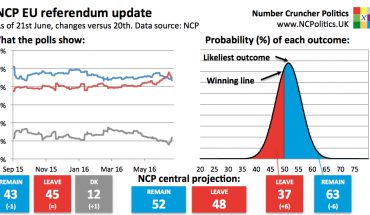In Britain we're not used to getting national election or referendum results at any level lower than the normal counting area (constituency or council area as appropriate). So it was a very nice surprise to hear that Martin Rosenbaum and George Greenwood at the BBC had approached every principal local authority in Britain to obtain the results breakdown at council ward level. They were able to obtain details of over 7 million votes, or 21 per cent of the total poll.
This represents 178 of the 399 council areas (the ones missing are disproportionately large). However the wards for which the numbers are available have an overall result of 51.5 to 48.5 to Leave, so each side is within 0.4 points of the actual result. So on that measure at least, we have a representative-looking subset of 1070 wards.
The reason so many are missing is (in many cases) that not all councils tally their vote totals by ward.
So what do they tell us? They confirm what we suspected about variation across very small distances. We know both from individual-level data and higher-level aggregate data that referendum voting correlated strongly with demographics, and since demographics vary considerably even between neighbouring wards, it isn’t too surprising that the results did too.
That underlines the fact that even within areas that were solidly Leave, there were patches of young professionals where Remain won and vice versa with Leave winning in pockets of older, less affluent voters even though it lost in the rest of the locality.
They also allow us to check the assumptions we’ve been making about low level Brexit geography, which is extremely helpful. Chris Hanretty has already revisited his constituency estimates, which held up very well indeed.
The breakdown between postal and non-postal votes is very interesting too. Where councils have made the entire count available with and without postal votes, the Remain share is about four points higher than on-the-day votes.
If this subset were representative of the country in terms of the relationship between the postal and non-postal votes, the latter would have voted 53-47 to Leave, but the former would have voted 51-49 to Remain.
This might surprise some, given that postal voters tend to be older, but they can also be affluent, busy urban professionals. And given this finding, perhaps the balance is a bit more of the latter.
And it certainly fits with my thinking around Remainers normally being more likely to vote (postal vote turnout was 88 per cent!) but Leavers being more likely to vote on 23rd June.
Postal votes do create a problem though. Because councils often mix them across wards, rather than allocating them to the voter’s actual ward, variation between wards in the same counting area becomes compressed. This (obviously) doesn’t effect the overall result but it does have the effect of pushing individual ward results closer to the average result across the whole council area.
How might we deal with this? One option is simply to ignore it, particularly if the objective is to aggregate wards back up to constituencies, thereby netting a lot of the errors off. This may still create difficulties within some of the larger local authority districts, though.
If we are going to try to answer how local communities actually voted, we probably need a way of factoring the distorting effect of postal vote mixing into any modelling. I actually have a testable theory of how to do this, so watch this space for details…
Ward level EU referendum results
|
6th February 2017 |





